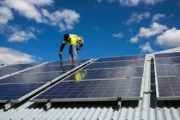
Investors seeing agriculture land as ‘a high-quality asset class’
The price of agricultural land has soared over the past four years – jumping by 18.4 per cent last year alone – and it’s now being seen as a viable asset for institutional and corporate investors, experts say.
“The sector has now really matured in terms of a high-quality, large-scale, institutional-grade asset class,” says Mark Barber, head of agribusiness investment services at Elders Rural Services. “We’ve seen a number of investors coming into the market and they’ve shown it can do very well.
“There’s also been an increase in liquidity if you’re looking for an investment opportunity and also an exit strategy.”
The convergence of low interest rates, the end of the 10-year drought, a return to above-average seasons and strong commodity prices have all played a part in raising the median price of agricultural land from $5061 a hectare nationally in 2018, to $7060 by the end of last year, on CoreLogic figures analysed by Elders for its Rural Property Update released this month.
Regionally, the price of farmland rose the most in Western Australia, at 41 per cent, then in Queensland by 28.9 per cent, Victoria by 28.4 per cent and NSW by 15.5 per cent.
Transaction volumes also increased by 3.4 per cent in 2021 to 9098 properties, the highest volume since 2017.
“Anyone looking to invest could have a very positive view of the future of the sector,” says Barber. “Prices and appreciation have been very strong indeed and there’s good cash flow, strong balance sheets and farm management deposits – where money is taken from a good year to put it against a bad one – are sitting at over $5 billion. We’ll see a solid market going forward.”
Debt funding is also currently at record low levels meaning landholders can afford to pay more for the same parcel of land, says Sam Douglas, manager agribusiness valuation and advisory services with Colliers.
Research is also enabling farmers to make better use of land, and the trickle-down of intergenerational wealth is further underpinning the sector’s strength.
The impact of COVID and its disruption of supply chains, as well as a renewed interest in self-sufficiency and producing more of our food ourselves, have also boosted the value of agricultural land and produce. “The cost of farm inputs such as fertiliser continue to rise, as key producers Russia and China look to service national demand, limiting global supply and driving prices for grain and oilseeds at the farm gate,” says Douglas.
“Commodity prices paid for products such as beef cattle have also trended upwards significantly, following prolonged periods of drought and reduction of herds with a temporary shortfall in supply and elevated prices per kilogram of meat.
“A scramble for processor supply in the dairy industry continues to support milk prices and buoy the cost of expansion opportunities,” he says.
With the further disruption to the sector by the war in Europe and escalating wheat prices, agriculture could be set for even more growth. At Bendigo and Adelaide Bank, which owns Rural Bank, spokesperson James Frost says that – in the lead-up to their own report coming out on May 3 – price growth of farmland and farm values have been incredible.
“It’s sometimes even exceeded the price growth we’ve seen in residential metropolitan markets in Sydney and Melbourne, which is quite astonishing,” he says.
This story is part of our April Agribusiness Feature. Read more of the stories here.










